Seaboard–All Florida Railway
The Seaboard–All Florida Railway was a subsidiary of the Seaboard Air Line Railroad that oversaw two major extensions of the system in the early 1920s to southern Florida on each coast during the land boom. One line extended the Seaboard's tracks on the east coast from West Palm Beach down to Miami (and later, Homestead), while the other extension on the west coast extended the tracks from Fort Ogden south to Fort Myers and Naples, with branches from Fort Myers to LaBelle and Punta Rassa. These two extensions were heavily championed by Seaboard president S. Davies Warfield (who died months after its completion), and were constructed by Foley Brothers railroad contractors. Both extensions also allowed the Seaboard to better compete with the Florida East Coast Railway and the Atlantic Coast Line Railroad, who already served the lower east and west coasts of Florida respectively.
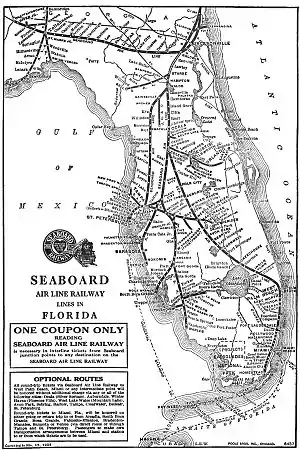 Seaboard Air Line 1936 map showing extensions built by the Seaboard-All Florida Railway on both coasts | |
| Overview | |
|---|---|
| Locale | East and West Coasts of Florida |
| Successor | Seaboard Air Line Railroad |
| Technical | |
| Track gauge | 4 ft 8 1⁄2 in (1,435 mm) standard gauge |
Today, only the east coast route survives and is now the state-owned South Florida Rail Corridor (which notably hosts Tri-Rail and Amtrak service for South Florida) and the Homestead Subdivision, which is still owned by CSX Transportation. The west coast route was removed in 1952 though a few related structures from the line still stand.
Grand opening celebration
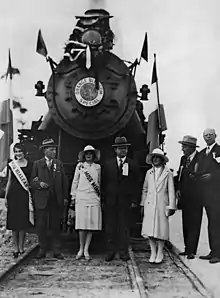
The Seaboard All-Florida Railway's west coast route commenced operation on January 7, 1927, and the east coast route began service the following day. On each opening day, President S. Davies Warfield rode aboard a special section of the Seaboard's Orange Blossom Special with a number of special guests and dignitaries including Florida Governor John W. Martin. Dorothy Walker Bush, mother of U.S. President George H. W. Bush was also aboard the first train to Miami.[1] The train stopped at points along the lines for public ovation with nearly 20,000 people attending. The two-day celebration is considered to be one of the largest public relations events in the history of American railroads.[2][3]
East Coast
Route and history
The east coast route began in West Palm Beach at the terminus of the Seaboard Air Line Railroad's recently completed Florida Western and Northern Railroad which originated at the Seaboard main line in Coleman. From West Palm Beach, the extension proceeded south, paralleling the Florida East Coast Railway which operated a short distance closer to the coast, through Delray Beach, Boca Raton, and Fort Lauderdale.
South of Fort Lauderdale, the line shifted farther inland, passing through Opa-locka, and Hialeah and then southeast into Downtown Miami, terminating at a now-severed connection with the Florida East Coast Railway. The original Miami passenger depot was built at 2206 NW 7th Ave in the Allapattah neighborhood.[4][5][6] A later extension branched off the line in Hialeah (near Miami International Airport) southwest towards Homestead, which was completed in 1927.[7] Some of the north end of Homestead extension was realigned in 1951 to accommodate the expansion of Miami International Airport.
Current operations
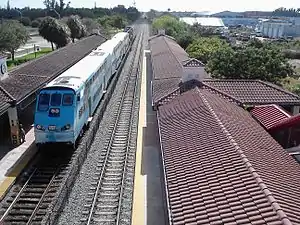
In more recent history, the Florida Department of Transportation purchased the east coast line from West Palm Beach to Miami International Airport from CSX Transportation (Seaboard's corporate successor through various mergers) in 1988 for $264 million, and is today the South Florida Rail Corridor.[8] Prior to the sale, the line was part of CSX's Miami Subdivision (a name which still applies to CSX's track north of the SFRC up to a point near North Palm Beach County Airport). FDOT bought the line, which closely parallels Interstate 95, to establish Tri-Rail, South Florida's commuter rail service, after an unsuccessful attempt to establish it on the Florida East Coast Railway. After the sale, CSX continued to maintain and provide dispatching for the line. In 2015, FDOT took over maintenance and dispatching, while CSX continues to have freight trackage rights.[9][10] CSX still owns the line south of the airport (at Oleander Junction) to Homestead, which is their Homestead Subdivision. The Homestead Subdivision is the southernmost trackage of the entire CSX network. Amtrak operates the Silver Meteor and Silver Star service from New York City to Miami over the line, both of which are former Seaboard passenger services. The original southern end of the line from Hialeah to Downtown Miami is now CSX's Downtown Spur.
Today, the original 1920s Seaboard stations are used by Amtrak and Tri-Rail for service at West Palm Beach, Deerfield Beach, Fort Lauderdale and Hollywood. Though no longer in use, the Seaboard stations at Delray Beach, Opa-locka, Hialeah, and Homestead are still standing.
Historic Station listing
| Milepost[11][12] | City | Station | Image | Connections and notes |
|---|---|---|---|---|
|
East Coast Main Line | ||||
| SX 969.9 | West Palm Beach | West Palm Beach | 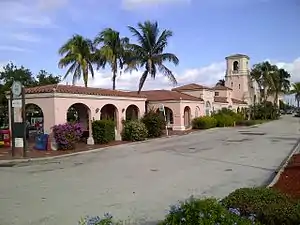 |
continues from Florida Western and Northern Railroad (SAL) |
| SX 976.5 | Lake Worth Beach | Lake Worth | ||
| SX 983.0 | Boynton Beach | Boynton | ||
| SX 987.5 | Delray Beach | Delray |  |
|
| SX 998.3 | Deerfield Beach | Deerfield |  |
|
| SX 1004.0 | Pompano Beach | Pompano | ||
| SX 1012.3 | Fort Lauderdale | Fort Lauderdale | 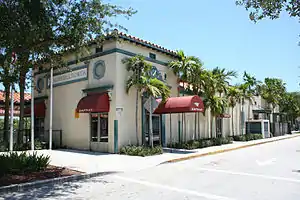 |
|
| SX 1016.4 | Dania Beach | Dania | ||
| SX 1019.7 | Hollywood | Hollywood | 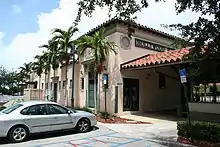 |
|
| SX 1021.1 | Hallandale Beach | Hallandale | ||
| SX 1025.7 | Uleta | |||
| SX 1030.0 | Opa-Locka | Opa-Locka | 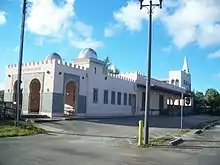 |
|
| SX 1036.3 | Hialeah | Hialeah | 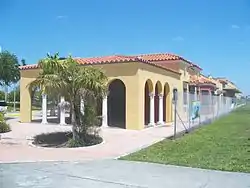 |
|
| SX 1036.5 | Hialeah Junction | junction with Homestead Subdivision | ||
| SXD 1040.0 | Miami | Miami | 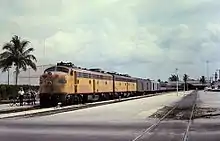 |
replaced by current Miami station in 1977 |
|
Homestead Subdivision | ||||
| SX 1037.2 | Hialeah Junction | junction with Miami Subdivision | ||
| SXH 1041.1 | Oleander | junction with Florida East Coast Railway Little River Branch | ||
| SXH 1043.3 | Coral Gables | Coral Gables | ||
| SXH 1047.0 | South Miami | South Miami | ||
| SXH 1055.5 | Richmond West | Richmond | ||
| SXH 1058.7 | Aladdin City | |||
| SXH 1062.8 | Redland | |||
| SXH 1066.4 | Homestead | Homestead | 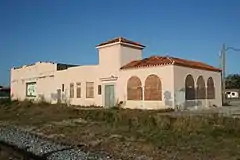 |
|
West Coast
Route and history
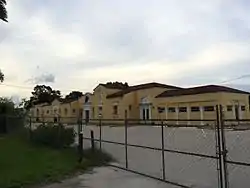

The west coast route began at Hull (just northeast of Fort Ogden), branching off of the Seaboard's recently acquired Charlotte Harbor and Northern Railway, and proceeded directly south in a nearly straight trajectory to Fort Myers. It crossed the Atlantic Coast Line's competing route twice en route to Fort Myers. Some of the former right of way is now a dirt road through the Fred C. Babcock/Cecil M. Webb Wildlife Management Area in southeastern Charlotte County. The line connected with a logging railroad operated by the Dowling and Camp Lumber Company near Slater.[13] As the line approached Fort Myers, it crossed the Caloosahatchee River on a long drawbridge just downstream of the original Tamiami Trail Bridge. The pier at Riverside Park in East Fort Myers is located where the bridge crossed the river.
In Fort Myers, the passenger depot was located just south of the river at the intersection of Palm Beach Boulevard (State Road 80) and East Riverside Drive. Henry Ford, a seasonal Fort Myers resident, used the station to reach his winter home (the Edison and Ford Winter Estates) on McGregor Boulevard.[14] Just south of the passenger depot, a separate freight depot (which still stands) was built along on Michigan Avenue. Today, Seaboard Street travels along the former right of way near the Fort Myers depots. From there, the line continued south out of the city along Palm Avenue and the west side of the Ten Mile Canal, closely paralleling the Atlantic Coast Line Railroad's competing route (operated today by Seminole Gulf Railway) on the other side of the canal.
At Mullock Creek, another subsidiary, the Naples, Seaboard, and Gulf Railway, continued the line the rest of the way to Naples. From the creek, it headed southeast through Estero (just west of the Koreshan Unity Settlement) to Bonita Springs.[15] In Bonita Springs, it turned south again before crossing the Imperial River. A passenger depot existed on the south side of Bonita Beach Road (near the site of First Presbyterian Church).[2] The line then joined the current route of Goodlette-Frank Road near Vanderbilt Beach and headed into downtown Naples, terminating at the Naples passenger depot on Fifth Avenue South. President Warfield had hoped to build a deep-water port in Naples, which was never built. Today, a FPL transmission line runs on most of the former route from Mullock Creek to just north of Downtown Naples.[15]
In addition to the main route, two branches existed from Fort Myers to LaBelle and Punta Rassa. The thirty-mile LaBelle branch began just south of the Fort Myers freight depot and ran just south of Michigan Avenue before turning northeast and continuing just south of and parallel to State Road 80. It terminated in downtown LaBelle at a depot at Main Street and Seminole Avenue.[16] In the 1940s, a seven-mile spur was built from the LaBelle branch southeast to Buckingham Army Airfield.[17] The 8-mile Punta Rassa branch departed the main line just south of Fort Myers near the Six Mile Cypress Slough. Despite its name, the branch never fully reached Punta Rassa, where President Warfield had also hoped to establish a deep-water port. It actually terminated in Truckland near Iona, just two miles short of Punta Rassa. The branch ran from the main route west along the current route of Six Mile Cypress Parkway, through the center of today's Lakes Park (south of and parallel to the park's scenic boardwalk), then southwest along the current routes of Summerlin Road and Pine Ridge Road before turning back north slightly to its terminus at McGregor Boulevard in Truckland. The Punta Rassa branch ended up mostly serving agricultural land and gladiolus fields near Biggar.[18] Power transmission line easements run on some of the former right of way of both the Labelle and Punta Rassa Branches.[19]
After the line opened, the Seaboard's Orange Blossom Special and West Coast Limited provided daily passenger service down the west coast.[20] Mixed train service (both passenger cars and freight combined) was offered from Fort Myers to LaBelle.
Decline and abandonment
Unlike the east coast route, the west coast route was not as successful and would exist for less than thirty years. The Seaboard Air Line went bankrupt in 1930 after the collapse of the land boom and in 1931, service to Fort Myers and Naples was reduced to a mixed train that operated three days a week. In 1933, only six years after the line opened, passenger service was discontinued entirely on the West Coast. By 1942, track was removed from Vanderbilt north to Punta Rassa Junction (located at present-day Six Mile Cypress Parkway's crossing of the Ten Mile Canal). The southernmost 7 miles of the line from Vanderbilt to downtown Naples and the Naples depot ended up being sold to the Atlantic Coast Line Railroad, who connected it to their parallel Naples Branch and made it their main route into Naples. This segment would remain in service until 1979.[21]
The rest of the west coast route was abandoned and removed by 1952. The Coast Line also reconstructed the first mile and a half of the Punta Rassa branch from their main line in the 1960s to briefly serve a rock mine just east of the Tamiami Trail (US 41) (site of Lakes Park).
Today, a few structures from the line remain. The Naples depot on Fifth Avenue South is now the home of a historical museum. The Fort Myers passenger depot most recently housed the Reilly Brothers Construction company and was demolished in August 2020.[14] The Fort Myers freight depot on Michigan Avenue most recently housed Gully's Discount Store Fixtures but is now vacant (the name "Ft. Myers Seaboard Freight Station" is faintly engraved on the side of the building).[21] The John Yarbrough Linear Park also runs near some of the line's former right of way south of Fort Myers next to the Ten Mile Canal.
Historic Station listing
| Milepost[22] | City/Location | Station | Connections and notes |
|---|---|---|---|
|
West Coast Main Line | |||
| SVC 893.4 | Hull | junction with Seaboard Air Line Railroad Boca Grande Subdivision | |
| VC 894.7 | Fort Ogden | junction with Atlantic Coast Line Railroad Lakeland–Fort Myers Line | |
| VC 904.8 | Saline | ||
| VC 916.7 | Gilchrist | junction with Atlantic Coast Line Railroad Lakeland–Fort Myers Line | |
| VC 919.7 | Tamiami | ||
| VC 923.2 | Salvista | ||
| VC 925.6 | Fort Myers | Fort Myers | Freight depot located half-mile south of passenger depot junction with:
|
| VC 934.3 | Punta Rassa Junction | junction with Punta Rassa Subdivision | |
| VC 940.7 | Estero | ||
| VC 948.8 | Bonita Springs | Bonita Springs | |
| VC 953.7 | Vanderbilt | ||
| VC 961.7 | Naples | Naples | |
|
LaBelle Subdivision | |||
| VO 925.6 | Fort Myers | Fort Myers | junction with Fort Myers Subdivision |
| VO 936.2 | Buckingham | ||
| VO 943.3 | Alva | ||
| VO 945.5 | Floweree | ||
| VO 955.1 | LaBelle | LaBelle | |
|
Punta Rassa Subdivision | |||
| VN 934.3 | Punta Rassa Junction | junction with Fort Myers Subdivision | |
| VN 936.7 | Biggar | ||
| VN 940.8 | San Carlos | ||
| VN 942.7 | Truckland | ||
References
- "Seaboard Railroad". Flashback Miami. Miami Herald. Retrieved 23 May 2019.
- Cottrill, Cathy (December 31, 2013). "Remember: Details sought about the Seaboard Air Line Railroad in Bonita Springs". The Banner. Retrieved 17 May 2014.
- Turner, Gregg M. (2004). A Milestone Celebration: The Seaboard Railway to Naples and Miami. AuthorHouse. ISBN 9781468517378.
- "Seaboard Railroad | Flashback Miami". flashbackmiami.com. Retrieved 16 November 2016.
- "1977 - Old Seaboard Air Line station - Miami Florida". rrpicturearchives.net. Retrieved 16 November 2016.
- "THE GREAT UNION STATIONS". chicagorailfan.com. Retrieved 16 November 2016.
- Turner, Gregg M. (2005). Florida Railroads in the 1920s. Arcadia Publishing.
- Turner, Gregg (2003). A Short History of Florida Railroads. Arcadia Publishing. ISBN 978-0-7385-2421-4.
- "South Florida transportation authority to take over rail corridor operation from CSXT". Progressive Railroading. Retrieved 13 October 2013.
- CSX Jacksonville Division Timetable
- Seaboard Coast Line Railroad Jacksonville Division and Tampa Division Timetable (1977)
- Bramson, Seth. "The Railroad Stations in Dade County" (PDF). Florida International University. Retrieved 20 May 2020.
- "Lumber Co. List". The Florida Railroad History Website - Fernandina & Cedar Key. Retrieved 9 June 2020.
- Dorsey, David (4 August 2020). "In the Know: Fort Myers train depot from 1920s to be demolished, surgery center sells". The News-Press. Retrieved 19 October 2020.
- "Estero Bay State Park Preserve". MPAtlas. Retrieved 15 November 2014.
- "National Register of Historic Places Multiple Property Documentation Form". National Park Service. United States Department of the Interior. Retrieved 4 November 2015.
- "MOS 580 — Remote Control Turret Mechanic-Gunner: SGT Floyd Richard McCormick" (PDF). Ancestry.com. Retrieved 11 October 2014.
- "Seaboard served Ft. Myers from 1926 to 1952". Railroad Museum SWFL. Retrieved 4 November 2015.
- "History at Hickey's Creek Mitigation Park" (PDF). Lee County Parks and Recreation. Retrieved 15 November 2014.
- Williams, Cynthia A. (22 November 2016). "Fort Myers railway station is turnstile to history". News-Press. Retrieved 14 July 2020.
- Turner, Gregg M. (December 1, 1999). Railroads of Southwest Florida. Images of America. Arcadia Publishing.
- Seaboard Air Line Railroad South Florida Division Timetable (1940)